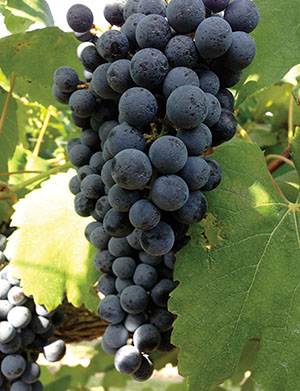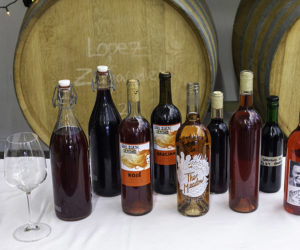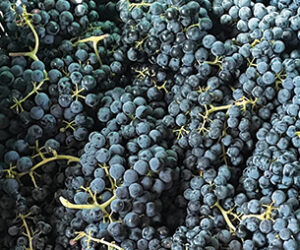
Will the real Black Spanish stand up? I have to admit, when we first decided on this variety as a topic, I had never thought I had made wine from it. However, this grape actually has many synonyms. Renowned wine author Jancis Robinson reports that depending on your location, it is referred to as Cigar Box, French Grape, Jacuet, Jacquez, Longworth’s Ohio, and in Australia, Troya. But when I got to a paragraph in her book, Wine Grapes: A Complete Guide to 1,368 Vine Varieties, Including Their Origins and Flavors, I had to pause and reflect, if this was indeed the grape I was supposed to write about. Black Spanish is listed as a synonym under the Jacquez header. The statement was “Jacquez and Listán Prieto (known as Mission in the United States) share the synonym Black Spanish but should not be confused.” There you have it, Robinson says not to be confused, and you the reader should not be confused either. Given the ever possibility of confusion on my part, I am still not sure what to write about as I am pressed against my deadline. Therefore, the mission of this article is Black Spanish! The real Black Spanish, according to Jancis. But to add to the confusion, the name I am familiar with in my own winemaking experiences is Lenoir, where it takes its name from the county where it grows in North Carolina.
All confusion aside, this red grape variety has large to medium-sized loose clusters. The flesh of the berries is red, leading to some highly pigmented wines. It can be quite vigorous and productive, producing large crops depending on the site. The growth is upright and the vineyards can crop at 4–8 tons of fruit per acre. The most common trellising used is the vertical shoot positioning, but the Geneva double curtain and high wire cordon systems have proven successful as well.
It is an interspecific hybrid, and by most reliable accounts, it was bred in Georgia by French Huguenots who settled in the region between 1730 and 1780. As was the case with most grapes from Europe, immigrants brought the varieties they were most familiar with on their journey to a new life in a new land. It is not known whether the hybridization was intentional or not, but what we do know is that it is a cross of Vitis aestivalis and an unknown vinifera variety, the resultant progeny are part of “botanically dubious” group known as Vitis bourquiniana. The “dubious” distinction refers to that there were other identified progeny of this aestivalis x vinifera and they were all described by Bailey in 1906 as “ameliorated forms of the native summer-grape, V. aestivalis.” But in 1988, the famous French ampelographer, Pierre Galet simply called them all hybrids. Its early dispersal across the southern US, where it does very well, was evidently due to one man, a Spaniard named Jacques.
The main upside of this interspecific breeding is that this variety is resistant to Pierce’s Disease (PD), a nearly always-fatal condition brought about by a tiny bacterium infecting the grapevine’s water transport system. The bacterium is Xylella fastidiosa and it is vectored into the grapevine by sap sucking insects. The bacterium is found across the southern United States from Florida to California. One Texas A&M publication on PD reports that at least thirty species of insects are responsible for vectoring the disease that can also infect peaches, citrus, oleanders, and olive trees. I am most familiar with Black Spanish as part of our PD resistance-breeding program at UC-Davis. Our research shows that the variety can tolerate high cell counts of the bacterium and not succumb to the disease.
Farming of all types has many inherent risks. Any given season produces a set of challenges as a result of weather, disease, or insect pressures, or any combination of these. In the vineyard, no wine region of the world is immune. Weather is probably the most devastating risk. We can’t stop the onslaught of severe storms that have raked across some of the best vineyards in the world. No region is immune. Weather induces secondary problems like fungal disease if it is too wet, or dehydration and desiccation if vines are not properly irrigated in hot conditions. Conventional farming can mitigate these challenges, while the organic and biodynamic practitioners have to be a little more creative. The viticulturist relies on some form of resistance to try to beat these odds. Because Black Spanish actually harbors high concentrations of the PD bacteria, and the vectors are present, viticulturists recommend against planting it in close proximity to PD susceptible varieties.
While Black Spanish is tolerant to PD, it is susceptible to downy mildew, black rot, and summer bunch rot. This can make growing in the more humid regions of the South problematic due to increased fungal disease pressures. Planting it on well-drained sandy soils tends to reduce some of the fungal pressures, and given its moderate resistance to phylloxera, actually makes it a good rootstock on those same soils.
Outside of the southern United States, surprisingly, there are still some vines left in the Cévennes, a range of mountains in south-central France. You may recall that hybrids were relied on heavily after their phylloxera epidemic in the late 1800s. Jacquet, as it is known there, was actually authorized for Châteauneuf-du-Pape until 1935 and most vineyards of it were pulled out in the 1950s. In our modern times, “wines of tradition” are still made from Jacquet but cannot be legally sold in the European Union because of its hybrid component. Hybrids are forbidden under the European Union either for sale of importation. Too bad, because there are many hybrids grown in regions where they are bred to thrive that make some really good wines. In Brazil, it is made into popular, slightly sweet red wines, but is also used to make juice and jelly products.
Acidity is reported to be high, which lends structure to the resultant wines made from it. In my experience, I tend to see the acidities on the lower side, but that is in California. We have a longer growing season than the rest of the country. Also the vineyards we are sourcing the fruit from are not “production for fruit” vineyards, rather vineyards that are grown for the production of bud wood for grafting and pollen for breeding. Some growers out of Texas report acidities in the range of 7–12 g/L at harvest. Harvest sugar targets of 20–25 °Brix are easily attainable depending on cropping level and the specific season that it is being grown.
My experience in winemaking with Black Spanish is to make a dry red wine. Specifically, that is what the PD research investigators would like. It is one of the “control” varieties by which to set a benchmark against for their new varieties coming out of their breeding program. But the grape is quite versatile. An early harvest can produce very nice rosé-style wines by taking advantage of the acidity and pigmented juice to crush and send the must to the press right away, before too much pigment is released from the skins. With the right equipment in the winery, whole-cluster pressing could be carried out to produce a blanc de noirs style. The adventurous might even consider taking this a step further to produce a sparkling wine. Sweeter versions can be made in a Port-style by fortifying with neutral brandy spirits to arrest the fermentation.
In some wine drinking circles, both domestically and internationally, wines made from hybrid grapes are considered taboo. Within the European Union no sales are permitted, and in California, where vinifera wines are king, they are just unknown. One of the highlights of the wines that we produce out of the breeding program is the blind tastings we conduct once or twice a year to evaluate their future. It is interesting to listen to the tasting descriptors and the rankings that come up, and at almost every tasting, two or three in the group rank the Black Spanish wine as their favorite. This proves, while not from a scientific base, rather a hedonic, that the perceived quality of a particular wine lies with the individual, and a good quality wine can be made from nearly any grape. A hard concept for some to grasp, but as my business partner often says about his day job, “I just have to work with the players I have been given.” That is the same with winemaking around North America, what does best in the field is what is the best in the local winery, and is what is the best in your glass tonight.
Black Spanish Recipe (5-gallons/19-L)
Ingredients
• 100 pounds (45 kg) fresh Black Spanish fruit
• Distilled water
• 10% potassium metabisulfite (KMBS) solution. Weigh 10 grams of KMBS, dissolve into about 50 milliliters (mL) of distilled water. When completely dissolved, make up to 100 mL total with distilled water.
• 5 grams Lalvin D254 yeast (Premier Cuvée can be used as a substitute)
• 5 grams Di-ammonium Phosphate (DAP)
• 5 grams Go-Ferm
• 5 grams Fermaid K (or equivalent yeast nutrient)
• Malolactic Fermentation Starter Culture
Other equipment or needs
• 15-gallon (57-L) food-grade plastic bucket for fermentation
• 5-gallon (19-L) carboy
• (1 or 2) 1-gallon (4-L) jugs
• Racking hoses
• De-stemmer/crusher
• Wine Press
• Inert Gas (nitrogen, argon or carbon dioxide)
• Ability to maintain a fermentation temperature of 80–85 °F (27–29 °C).
• Thermometer capable of measuring between 40–110 °F (4–43 °C) in one degree increments.
• Pipettes with the ability to add in increments of 1 mL
• Ability to measure residual sugar at the completion of fermentation.
Step by Step
1. Clean and sanitize all your winemaking tools, supplies and equipment.
2. Crush and de-stem the grapes. Transfer must to your fermenter.
3. During the transfer, add 15 mL of 10% KMBS solution (This is the equivalent of 50 ppm SO2). Mix well.
4. Take a sample to test for Brix.
5. Layer the headspace with inert gas and keep covered. Keep in a cool place overnight.
6. The next day, sprinkle Fermaid K directly on the must and mix well.
7. Prepare yeast. Heat about 50 mL distilled water to 108 °F (42 °C). Mix the Go-Ferm into the water to make a suspension. Take the temperature. Pitch the yeast when the suspension is 104 °F (40 °C). Sprinkle the yeast on the surface and gently mix so that no clumps exist. Let sit for 15 minutes undisturbed. Measure the temperature of the yeast suspension and the must. You do not want to add the yeast to your cool juice if the variance in temperature exceeds 15 °F (8 °C). To avoid temperature shock, you should acclimate your yeast by taking about 10 mL of the must juice and add it to the yeast suspension. Wait 15 minutes and measure the temperature again. Do this until you are within the specified temperature range.
8. When the yeast is ready, add it to the must and stir thoroughly.
9. You should see signs of fermentation within one to two days. This will appear as some foaming on the must surface and the berries will rise to the top. This is referred to as the “cap rise.”
10. You need to have on hand the ability to push the grapes back into the juice to promote color and tannin extraction (punching down). This should be done three times per day. Use a clean utensil or your hand to mix, making sure the berries get completely immersed before the cap starts rising again.
11. Keep the temperature between 80-85 °F (27–29°C). Monitor the Brix and temperature twice daily during peak fermentation (21 down to 10 °Brix), and more often if the temperature shows any indication of falling out of this range. If needed, warm or cool the must to keep it in this range.
12. At about 19 °Brix, dissolve the DAP in a small amount of distilled water and mix it into the must.
13. When the Brix reaches zero (about 6–10 days), transfer the free-run wine to your carboys and/or 1-gallon (4-L) jugs, and transfer the grape solids to your press and press the cake dry. Keep the free-run wine separate from the press portion for now. Be sure to label your vessels to keep the press portion separate. Your press fraction may only be a gallon or two (4–8 L). Make sure you do not have any headspace. Place an airlock on the vessel(s). The fermentation may perk up a little here as the primary fermentation completes. When activity starts to slow, measure the residual sugar through tasting, or by sending a sample to an outside lab. The wine is considered dry if the residual sugar is less than 2 g/L.
14. Inoculate both the free- and press-run wines with your malolactic (ML) bacteria. Check the manufacturer’s instruction on how to prepare and inoculate. Cover the tops with an airlock to allow CO2 to escape.
15. Monitor the malolactic fermentation (MLF) using a thin layer chromatography assay. Follow the instructions included in the kit.
16. When the MLF is complete, add 2 mL of fresh KMBS (10%) solution per gallon (4 L) of wine. This is the equivalent to ~40 ppm addition.
17. Place the wine in a cool place to settle.
18. After two weeks, test for SO2, adjust the SO2 as necessary based on wine pH to attain 0.5 ppm molecular SO2. (There is a simple SO2 calculator at www.winemakermag.com/sulfitecalculator). Check the SO2 in another two weeks and adjust. Once the free SO2 is adjusted, maintain at this level. Check every two months or so, and before racking.
19. Rack the wine clean twice over 6–8 months to clarify. Consider during this period using some oak chips to add some oak flavors, but don’t expose the wine too long to the oak. One to two weeks, sometimes less, is sufficient for this volume. Taste frequently to your preference of extraction.
20. Once the wine is cleared, it is time to move it to the bottle. This should be about eight months after the completion of fermentation.
21. Make the project fun by having a blending party to integrate the press fraction back into the free run. You may not need it all, use your judgment and make what you like.
22. Maintain sanitary conditions while bottling. After bottling, periodically check your work by opening a bottle to enjoy with friends.







